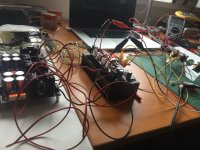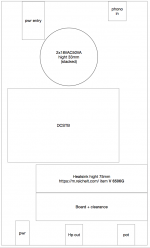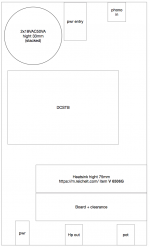Hi Folks 
I've tested the OPA2134 now for quite a while in the DCG3. There are small, but noticable, differences between AD823 and OPA2134.
I try to describe them that way:
The OPA2134 is smoother at the high end with less „sparkles“ but does another stereo illustration, less wide but better focused.
The mid bass is better controlled. But losing the „sparkles“ ist not what I really want.
The AD823 does better high ends. Overall more exciting in listening.
Now I’m not sure wether I should use the AD or OPA. Actually I’m listening with AD
…maybe I’ll change it back to OPA ...or not
I've tested the OPA2134 now for quite a while in the DCG3. There are small, but noticable, differences between AD823 and OPA2134.
I try to describe them that way:
The OPA2134 is smoother at the high end with less „sparkles“ but does another stereo illustration, less wide but better focused.
The mid bass is better controlled. But losing the „sparkles“ ist not what I really want.
The AD823 does better high ends. Overall more exciting in listening.
Now I’m not sure wether I should use the AD or OPA. Actually I’m listening with AD
…maybe I’ll change it back to OPA ...or not
Last edited:
I have tried tens of types even before first presenting the design including those two OPA.
My impressions are there are small differences indeed that are picked up mainly with headphones but they exist. OPA2134 does tighter mid-bass but its less spacious than AD823 and OPA2604 has family resemblance but more energetic in pace and highs than OPA2134 though maybe bit rougher too. Its mainly about what details are suiting specific transducers better. On big speakers when listening from afar those details can be obscured.
My impressions are there are small differences indeed that are picked up mainly with headphones but they exist. OPA2134 does tighter mid-bass but its less spacious than AD823 and OPA2604 has family resemblance but more energetic in pace and highs than OPA2134 though maybe bit rougher too. Its mainly about what details are suiting specific transducers better. On big speakers when listening from afar those details can be obscured.
Did you try it both OPA 2134 and 2604?
What was your impression of OPA2134?
LOL...so now folks are getting a "different " sound depending on the choice of the servo op-amp?
Really??

I'm willing to bet that you can not hear any differences in a blind listening test between any of the JFET servo op-amps people have tried in this DCG3 design.
Those are active electronic devices operating as an integrator in parallel to the main feedback path. A noisy one with enough THD can make the grass substantially higher in the FFT graph especially at 1/f and can add harmonics %. I have seen that with the TL072 in the DCG3. The better more modern ones were basically benign in the graph. So they do live in the shadows and can even objectively appear if given a chance. In blind testing I am sure I wouldn't tell apart a live cat's meow from a Fostex full range desktop speaker asking for Friskies anyway 
P.S.
Ammel68, in the recent past I advised you not to be combatant around here before mods will take notice (since we do not moderate in our own threads to avoid prejudice) but then you went to other threads in even more combatant style. Members reports started flying in and you eventually got banned. Now its late even when appearing as a rather more gentle (for now) solder slinger24. Using a sockpuppet online identity is a big offense in the forum's rules. The platform's tracing software identified you as the same person already.
P.S.
Ammel68, in the recent past I advised you not to be combatant around here before mods will take notice (since we do not moderate in our own threads to avoid prejudice) but then you went to other threads in even more combatant style. Members reports started flying in and you eventually got banned. Now its late even when appearing as a rather more gentle (for now) solder slinger24. Using a sockpuppet online identity is a big offense in the forum's rules. The platform's tracing software identified you as the same person already.
Moderator on another hifi forum myself. Some people never learn.
Anyway - have repaired a Conrad Johnson MF2500 amp. Testing with the dcg3 I got a really bad ground loop problem. If I couple direct with my dac (omitting the dcg3) it is no problem. Any grounding tips I should be aware of?
dcg3 with my Ovation-sx class A amp it is dead silent but not so with the CJ. Since the dcg3 worked 100% from day 1 I have never looked back and thought more about the grounding.
The rca´s is actually connected to chassis (safety ground) via the 3.5mm headphone out.
That is probably not the best way I guess.
Havent given this much thought until now.
Anyway - have repaired a Conrad Johnson MF2500 amp. Testing with the dcg3 I got a really bad ground loop problem. If I couple direct with my dac (omitting the dcg3) it is no problem. Any grounding tips I should be aware of?
dcg3 with my Ovation-sx class A amp it is dead silent but not so with the CJ. Since the dcg3 worked 100% from day 1 I have never looked back and thought more about the grounding.
The rca´s is actually connected to chassis (safety ground) via the 3.5mm headphone out.
That is probably not the best way I guess.
Havent given this much thought until now.
Moderator on another hifi forum myself. Some people never learn.
Anyway - have repaired a Conrad Johnson MF2500 amp. Testing with the dcg3 I got a really bad ground loop problem. If I couple direct with my dac (omitting the dcg3) it is no problem. Any grounding tips I should be aware of?
dcg3 with my Ovation-sx class A amp it is dead silent but not so with the CJ. Since the dcg3 worked 100% from day 1 I have never looked back and thought more about the grounding.
The rca´s is actually connected to chassis (safety ground) via the 3.5mm headphone out.
That is probably not the best way I guess.
Havent given this much thought until now.
First thing to try would be to lift that wire from the chassis and see if interfacing becomes hum free with that CJ amp too. If so happens you may use a couple of Yin Yang oriented 5A diodes between that wire and chassis so it remains lifted unless a hard fault happens. The diodes possibly bypassed by a 10Ω 5W loop breaker resistor and a 10nF RF grounding capacitor.
If no success with that let me know so to guide you modify the DCG3's main ground lane with a hobby knife cut for a more hardcore hum loop investigation scenario.
Case layout question and build proof
Hi,
This weekend I finally had the DCSTB/DCG3 combo running! Was only a quick test but seems to work pretty good
Question on case layout in the back region of the case (power and signal entry).
Tia
Steef
Hi,
This weekend I finally had the DCSTB/DCG3 combo running! Was only a quick test but seems to work pretty good
Question on case layout in the back region of the case (power and signal entry).
- Is it preferable to place signal and power entry as far away from each other as possible, with the consequence of the toroids being pretty close to the signal inputs, or
- is it preferable to place signal entry and toroids as far away from each other as possible, with the consequence of the power entry being pretty close to the signal inputs
Tia
Steef
Attachments
Just lifted (removed) the 3.5mm headphone out. No hum at all with the CJ amp.
It was just a temorary solution anyway. Will fit another headphone adapter to the dcg3. Any suggestions.
The key is to clarify what problem did that removal solve. Was it making an unwanted signal earth body connection to chassis? If yes then find one that is insulated. Did that jack have some function other than simple connection? Like lifting some contact when engaged/not engaged and making/breaking some earthing scheme? Maybe you had two returns one for each channel to that jack and the wire to chassis from the HP out works better if only with one channel return to that jack in combination with the CJ amp? Got to identify what hum loop was broken by that removal. So not to repeat it with a new jack and its wiring.
Hi,
This weekend I finally had the DCSTB/DCG3 combo running! Was only a quick test but seems to work pretty good
Question on case layout in the back region of the case (power and signal entry).
See attached pics for the differences. Other comments?
- Is it preferable to place signal and power entry as far away from each other as possible, with the consequence of the toroids being pretty close to the signal inputs, or
- is it preferable to place signal entry and toroids as far away from each other as possible, with the consequence of the power entry being pretty close to the signal inputs
Tia
Steef
Steef hi,
Is it a magnetically shielded toroid or a simple one?
Hi Salas,
It is a toroidy.pl one AUDIO GRADE. They state
Thanks
Steef
It is a toroidy.pl one AUDIO GRADE. They state
AUDIO grade transformers for use in amplifiers and other high-class audio devices.
Unlike commercial power line transformers, the AUDIO version is covered on the outside with a black Mylar tape which gives it an aesthetic appearance. The epoxy filled center with an opening for the M6 screw eliminates a need for an additional mounting bracket. The neoprene gum pad affixed to the bottom successfully eliminates transmission of vibrations.
The entire construction utilizes high-class, laboratory-tested parts. The core and the windings are impregnated, and the production process is being scrupulously controlled at every step.
Additional magnetic screening and the electric monitor of coated SYN-SHIELD copper tape between windings make the class AUDIO transformers one of the frontrunners in the area of safe use in the systems of electronic power supply.
Thanks
Steef
States magnetic screening. In this case I would have preferred your first option. Dress the mains wires hard left and turn the transformer in best way possible to gain distance between the signal wiring and all trafo wiring but especially its secondary exits which are the most potent for current and field making. Use shielded coax for all signal wiring.
- Home
- Source & Line
- Analog Line Level
- Salas DCG3 preamp (line & headphone)


